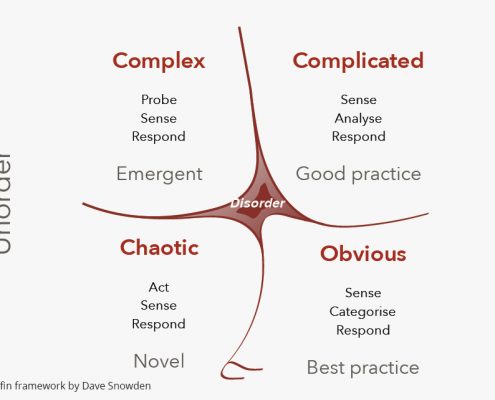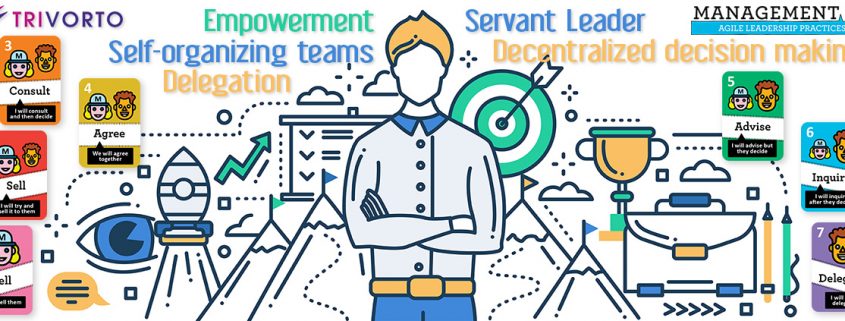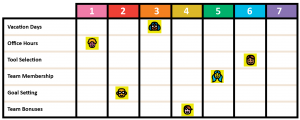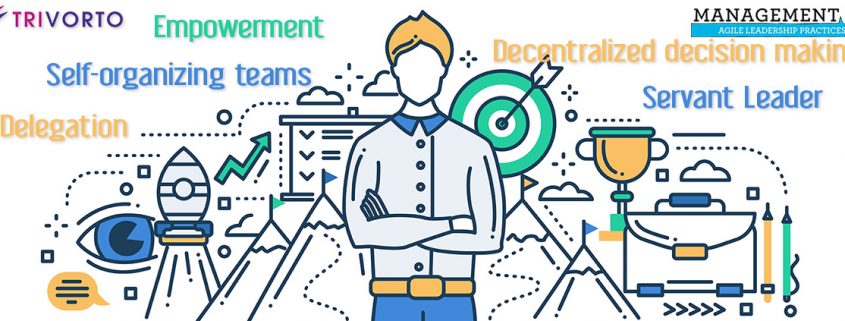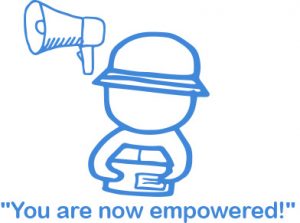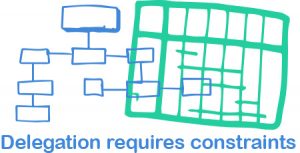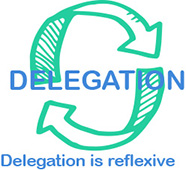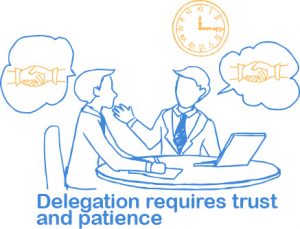Why innovation needs to be continuous
Innovation is a hot topic nowadays. Many organisations are investing in some form of innovation lab or internal accelerator program. Or they separate new business ventures from the main organisation by starting a startup-like small company. Or acquire one for that matter. Many are experimenting with concepts like lean startup, business model innovation, or design thinking to give their innovation powers a boost. What these companies have in common is they realize their business models won’t last for ever. What they also seem to have in common most often is the idea that you can successfully externalize innovation from the rest of your organisation. This seems to tag along with the idea that you only need to innovate once (successfully) to be safe for a while again. But is this true?
 Most decision makers agree their business models are or will be under pressure. They need some form of innovation. Yet there are plenty of examples that illustrate how hard it is to innovate in time. Upon the introduction of the iPhone, RIM’s CEO Jim Balsillie, told a Reuters reporter that the launch of Apple’s iPhone wasn’t a major threat, simply the entry of yet another competitor into the smartphone market. We all know how that ended. Toys ‘R US always seemed like a rock solid name to me. I didn’t even realize the company dated back to the fifties. Yet, the company filed for bankruptcy in September 2017. RadioShack was a household name for decades in the US after it filed for bankruptcy for the second time in 2017. What these companies have in common is that they were once highly successful, but didn’t manage to turn the ship around fast enough to survive or stay relevant.
Most decision makers agree their business models are or will be under pressure. They need some form of innovation. Yet there are plenty of examples that illustrate how hard it is to innovate in time. Upon the introduction of the iPhone, RIM’s CEO Jim Balsillie, told a Reuters reporter that the launch of Apple’s iPhone wasn’t a major threat, simply the entry of yet another competitor into the smartphone market. We all know how that ended. Toys ‘R US always seemed like a rock solid name to me. I didn’t even realize the company dated back to the fifties. Yet, the company filed for bankruptcy in September 2017. RadioShack was a household name for decades in the US after it filed for bankruptcy for the second time in 2017. What these companies have in common is that they were once highly successful, but didn’t manage to turn the ship around fast enough to survive or stay relevant.
 Another faded name is Palm. What is interesting about Palm was that they did not start out as a hardware company. They first provided software for other brands devices. Devices that largely failed commercially. But somehow Palm reinvented themselves in-time and popularized the PDA. They actually tried to reinvent themselves a couple of times during their period of existence with the rise of smartphones, and with the introduction of their WebOS platform. But none of those attempts rivaled the success of their first reincarnation. The history of Palm seems to suggest that in order to survive in the long run a company must reinvent itself in time. But one time is not enough as the new business model will eventually fade as well. This would mean that the key to long term success is not so much the ability to innovate but the ability to do it continuously. So it is not the innovation itself that counts, but the ability to continuously test new waters; grow and nurture successful business models, and pull out in time in favor of new more promising opportunities.
Another faded name is Palm. What is interesting about Palm was that they did not start out as a hardware company. They first provided software for other brands devices. Devices that largely failed commercially. But somehow Palm reinvented themselves in-time and popularized the PDA. They actually tried to reinvent themselves a couple of times during their period of existence with the rise of smartphones, and with the introduction of their WebOS platform. But none of those attempts rivaled the success of their first reincarnation. The history of Palm seems to suggest that in order to survive in the long run a company must reinvent itself in time. But one time is not enough as the new business model will eventually fade as well. This would mean that the key to long term success is not so much the ability to innovate but the ability to do it continuously. So it is not the innovation itself that counts, but the ability to continuously test new waters; grow and nurture successful business models, and pull out in time in favor of new more promising opportunities.
Continuous innovation makes sense when the life-cycle of a business model is either short, or unpredictable. Or both.
Continuous innovation only makes sense if the life-cycle of a business model is either short, or unpredictable. Or both. We argue this is the case in most industries nowadays. Let’s investigate why. One of the major reasons is that barriers of entry for newcomers are dramatically lowered:
- The access to information and knowledge is now almost equal for anyone. Protecting a market by superior knowledge once was a standard way to protect your competitive advantage.
- Access to talent is easier. People can work everywhere nowadays, we don’t necessarily have to gather in the same office building everyday anymore.
- Capital is more easily obtainable. Although investment funds seem to have raised the bar lately, there are still many accelerator programs, startup boot camps, and corporate incubator programs. Angel investors are a valid option for many, and crowd-funding platforms are still growing.
- Access to capital is not only easier, companies typically also need less of it to start. Launching a product or service, especially online, has never been faster and cheaper.
- According to Ash Maurya you can launch and grow a business from anywhere these days. Geographic borders are down. Even more, you can be a global player too. As Hal Varian, Chief Economist at Google, puts it:
If the late 20th Century was the age of the multinational company, the early 21st will be the age of the micro-multinationals: small companies that operate globally.
The competitive landscape has been majorly disrupted because of this. However, most companies are designed to defend their business models over a long period of time. They are designed to squeeze the last bit of efficiency out of a business model before giving up. As a consequence they are ill equipped for fast and repeatedly innovation. This explains the popularity of organizing innovation away from the core of the organization, shielding it from the slow bureaucracy of the organisation. There is an even more profound and important consequence that business leaders need to understand and accept in order to have a decent chance to lead their organizations to long-term success:
A sustainable competitive advantage no longer exists.
 Let that sink in for a minute… Competitive Advantage is mostly described as the ability of an organization to outperform its competitors. It is also the title of the 1985 book from Michael Porter, undeniably the textbook on this subject. The biggest problem of Porter’s model lies in the assumption that a competitive advantage can be sustainable, that is: you can successfully defend your competitive advantage over long periods of time. In today’s world of fast change and high complexity, that is a dangerous assumption to bet on. The business graveyard lies full of once well-known and relevant names of companies who held on to that belief for too long. Rita Gunther McGrath, a renowned expert in this field, puts it this way:
Let that sink in for a minute… Competitive Advantage is mostly described as the ability of an organization to outperform its competitors. It is also the title of the 1985 book from Michael Porter, undeniably the textbook on this subject. The biggest problem of Porter’s model lies in the assumption that a competitive advantage can be sustainable, that is: you can successfully defend your competitive advantage over long periods of time. In today’s world of fast change and high complexity, that is a dangerous assumption to bet on. The business graveyard lies full of once well-known and relevant names of companies who held on to that belief for too long. Rita Gunther McGrath, a renowned expert in this field, puts it this way:
When competitive advantages don’t last, or last for a much shorter time than they used to, the strategy playbook needs to change.
The pace of change is just too high for a strategy based on sustainable competitive advantage to keep up. The lowered barriers of entry make it very hard to successfully defend a competitive advantage, and besides, who wants to be on the defense forever? Therefore, innovation needs to be continuous. But that brings us back to the question whether it is a good idea to externalize innovation. I think you can guess my answer by now. It is not. While an accelerator program can come up with some promising new business ideas, and a startup like separate company can prove some viability in a new opportunity, nothing has fundamentally changed to the core of the organisation. While a small nimble part of the organisation comes up with new ideas, the rest of the organisation is still aimed at defending a competitive advantage, at maximizing efficiency, and gaining economies of scale. It is still a slow bureaucratic oil tanker. What happens if the new business models eventually are absorbed into the mother organisation? In the end you have gained little. What’s needed it what we call an adaptive organisation:
The Adaptive Organization has the core ability to continuously reinvent itself.
Although it is applaudable that companies take initiative in innovation programs, I am afraid that the current prevailing strategy of externalizing it, will bring disappointing results in the long run. It also feels like senior management is not all in: they still bank on the current main organisation, and innovation is still a separate show that can easily be canceled once its popularity starts fading. Let’s finish with a quote of the famous Peter Drucker:
Because the purpose of business is to create a customer, the business enterprise has two–and only two–basic functions: marketing and innovation
If would want to learn more about continuous innovation, you can attend one of our Continuous Innovation workshops. Or contact us for a talk.
Sources:
[Dabrowski, W. (2007). “Update 1-RIM Co-CEO doesn’t see threat from Apple’s iPhone”. Reuters.]
[Hal Varian (2011). Micro-multinationals will run the world. http://foreignpolicy.com/2011/08/15/micromultinationals-will-run-the-world/]
[McGrath, Rita Gunther. (2013). The end of competitive advantage. Harvard Business Review Press. p. 4.]








